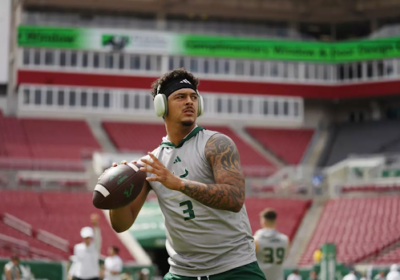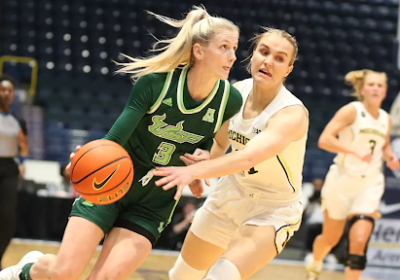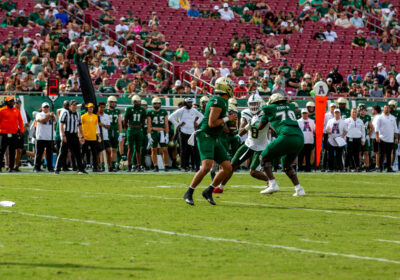The future of sports lies in the hands of pro gamers

“Welcome to the future.”
“The future is now.”
That was how Fox Sports Florida anchor Paul Kennedy opened the very first USF eSports Summit.
Students and business professionals flocked to the USF Muma College of Business atrium Wednesday to listen to eight panels of speakers talk about none other than video games.
More specifically, the industry of esports and how it has the opportunity to surpass the traditional sports industry in terms of revenue, coverage and fans.
The esports industry is approaching $1 billion in revenue for 2019, according to Newzoo, the global leader in esports analytics. The industry is also rapidly growing at 30 percent a year.
The numbers are there to back investment into the industry, which is exactly what Tampa Bay Lightning owner Jeff Vinik did.
In June 2017, Vinik invested in aXiomatic, which connects esports, investors and the media.
Vinik became the co-executive chairman because he saw the value of the budding esports industry. He also saw the potential in the heavy hitters in the esports world.
The industry is already seeing big-money moves, likened to the moves seen in traditional sports. In early August, the popular Fortnite streamer Ninja was paid approximately $14 million by Microsoft to exclusively stream on Mixer, Microsoft’s own streaming platform.
Individual gamers are also becoming increasingly more marketable, which explains why Microsoft was willing to invest so much money on one streamer.
Sponsors like Red Bull, Mountain Dew, Intel and Samsung will pay upward of $1 million for professional gamers to use their products. This is already the case with professional athletes.
But what makes esports so marketable is how easy it is to get into — as many of Wednesday’s speakers mentioned, all you need is access to a console.
Streaming platforms like Mixer, YouTube Gaming and Twitch make it significantly easier for gamers to establish themselves. Established streamers are often transparent on how they developed their skills and their brand. In turn, more and more gamers are dedicating themselves to going pro.
Another trend that the industry is seeing is broadcasting. Tournaments like the Overwatch League (OWL) are broadcast in prime time on ESPN.
Jewel Rattanakongkham, a USF student, aspiring professional Overwatch player and a self-proclaimed fan of the OWL team New York Excelsior, was surprised to see OWL broadcast on a sports network.
“I just followed sports because my parents did,” Rattanakongkham said. “When I saw esports on ESPN, my dad was like, ‘Hey, that game you like is on TV,’ and I was like, ‘Oh my god, that’s insane,’ and I’m really happy it’s now becoming seen as like another sport.”
Rattankongkham has friends who are currently in OWL — FCTFCTN of Los Angeles Valiant and sleepy of Washington Justice. She and her friends go through a similar intense training regiment.
“When I first started out playing Overwatch, I had one week where I played over 123 matches, which is over 60 hours. I spent days playing and grinding and just getting better.”
What separates esports from traditional sports is that esports are constantly in development. There are constantly new teams and rules being introduced, which keeps a fresh interest in it.
“I know there are other games like [League of Legends], or now Apex Legends, now a new league, and then there’s Fortnite,” Rattankongkham said. “And they’re constantly changing things with the meta so I think that’ll be a little more interesting.”
There seems to be a built-up competition between the following of traditional sports and esports, according to the speakers. A few people who attended discussed whether esports can surpass the following of the NFL.
But Kennedy said this isn’t the case. Both traditional sports and esports can coexist because, on average, the demographics of the fan bases are so different.
The average age of an NFL fan is 50, according to Radio & Television Business Report. Meanwhile, the average age of a fan of OWL is 28, according to GameScape.
The question is whether the relatively young fans of OWL stick with supporting esports.
It’s a part of the evolution of sports, according to Kennedy.
“It’s no more improbable than the original Greeks believing that one day baseball will be a part of the Olympics,” Kennedy said.
Just like traditional sports, there is a potential for esports to sell out arenas, something already seen in OWL.
Marcus Watts, a former professional basketball player and current digital media strategist, says that he didn’t know that esports had the following they had until he saw a sold-out arena.
“My step-brother is actually the captain of Team USA Overwatch and the captain of the Dallas Fuel,” Watts said. “So I didn’t know it was that good until I saw that they were like selling out whole arenas.”
Selling out arenas is one of the things that investors like Vinik want to see. At the end of the day, the sports that make the most profit will receive the most coverage.
With Vinik’s involvement in the Tampa Bay area, he said there may be a chance Tampa may become one of the centers for esports. That would potentially mean a dedicated esports arena, similar to the esports Arenas seen on the West Coast.
But it’s still a fledgling industry and a majority of investors still aren’t keen on the idea just yet, despite the eruptive start of esports.
“When you talk to executives over the age of 35 to 40, they’re skeptical,” said Michelle Harrolle, director of the USF Vinik Sports and Entertainment Management program.
However, Vinik remains dedicated. He said he currently doesn’t have a plan in place to build a dedicated esports arena in Tampa, but he didn’t rule out the idea entirely.
“Keep watching and stay alert. Opportunities will come,” he said.






